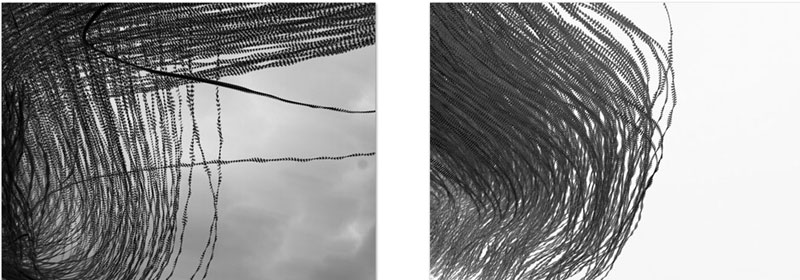Across the natural world organisms as diverse as bacteria, insects, fish, birds and mammals, including humans, often behave collectively, producing spectacular, cohesive group-level patterns. Traditionally, it has been thought that the collective behaviour of such swarms, schools, flocks and crowds arises if individuals follow simple, fixed rules of interaction with their neighbours. New research funded by the Human Frontier Science Program shows that these rules of interaction can actually show dramatic flexibility across different contexts, leading to distinct group-level properties.

Photographs combining all of the images collected from one camera during the passage of a jackdaw flock. Each ribbon is the path taken by a single bird, with oscillations in the ribbons showing the wingbeats of each individual. Credit Hangjian Ling & Guill McIvor.
The project brought together an interdisciplinary team of biologists (Alex Thornton and Guill McIvor from the University of Exeter, UK) and physicists (Nicholas Ouellette and Hangjian Ling, Stanford, USA) with computer scientist Richard Vaughan (Simon Fraser University, Canada) to study flocks of jackdaws, highly social birds of the crow family. Using arrays of high-speed cameras, the team recorded the 3D movements of all individuals within flocks of wild jackdaws in Cornwall, UK, across two different contexts: transit flocks flying towards their winter roosts, and mobbing flocks, where individuals gather together to inspect and drive away a predator.
When in transit to winter roosts, jackdaws follow what are known as ‘topological rules’ – meaning that individuals respond to the movements of a fixed number of neighbours, and groups remain ordered regardless of how many birds are flying together. In contrast, when mobbing a predator, the jackdaws instead used ‘metric rules’ where they respond to all the neighbours that are within a given distance. In these mobbing flocks there is a sudden transition from order to chaos. Mobbing flocks begin to form when jackdaws produce alarm calls to recruit others to join the mob, and at first these groups are completely disordered. Then, when the density of birds reaches a certain threshold, it suddenly flips into an ordered, cohesive state where the birds are aligned with their neighbours and move together in an organised way. This sudden transition from disorder to order is similar to the phase transitions we see in physics, like the change from steam to liquid water.
These findings suggest that, rather than been limited to fixed interaction rules, animals may instead adjust their responses to neighbours to optimise the function of the group in different contexts. The work may also have implications for the design of autonomous vehicles. Swarms of unmanned aerial vehicles or drones have potential uses in many applications including ecological surveys, fire-fighting and search-and-rescue in remote regions. By learning from the behaviour of jackdaws, we may be able to begin to design drones that modify their swarming behaviour to maximise their efficiency in different contexts.
The paper, published in the journal Nature Communications, is entitled: “Behavioural plasticity and the transition to order in jackdaw flocks.”
Video: Transition from disorder to an ordered state in a flock of mobbing jackdaws. Credit Guill McIvor.


































